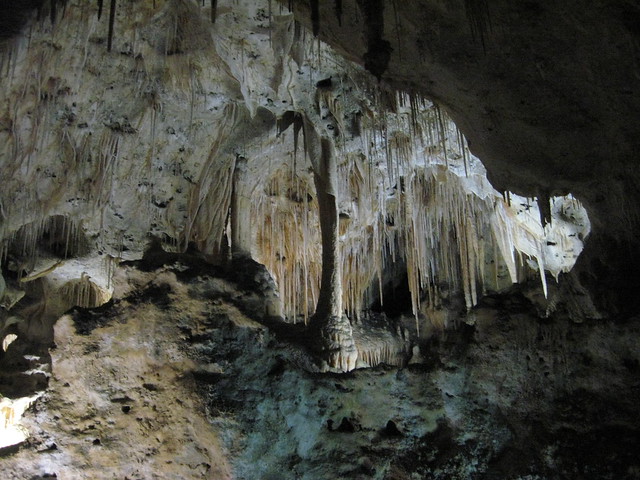

More photos from Carlsbad Caverns, more photos from Mammoth Cave.
What jumps out to me is the green stain on the wall in the picture from Mammoth Cave. This is something I really noticed while touring the cave and there was some really drastic growth on some of the walls in the New Entrance portion of the cave. According to Smith and Olson (2007) these are some of the 28 species of cyanobacteria, green algae, and/or diatoms. For the rest of this article I will refer to all of these groups as algae, because that is far easier than typing all those out every time. All of these groups are photosynthetic groups that need light as well as moisture to live and since they produce their own food they can grow on cave walls. Algae as well are known as pioneer species meaning, in this case, that they live on rocks, unlike plants which need soil to grow, and in the process they modify the rocks under them by producing weak acids during photosynthesis that break down the rocks they are on. On the surface where algae lives naturally this is a good thing, it is a form of chemical weathering that breaks the bonds that hold the rock together and forms soils in the long run, except in karst areas because it is hard to produce soil from limestone (not going to explain here if you want to know ask). In caves the algae are doing the same thing except that they naturally only occur where the sun shines so in order for them to grow deep down in caves is because we put lights down there.
So why so much more algae in Mammoth Cave than in Carlsbad Caverns? Some of it may have to do with the outside environments of the two areas. Carlsbad is in a desert and Mammoth Cave is in a temperate forest so it is going to be much more moist in Mammoth Cave. Carlsbad does, however, have algae that grows on the surface outside the cave. The main difference has to do with the type of lights that have been installed within the cave. Carlsbad Caverns has been moving toward lights that produce light at a wavelength that the algae cannot grow at (on a side note if you go to the link they talk about how they are changing the lights again and you can see some of that in my pictures). There is still some need to physically remove the algae as the Carlsbad website mentions:
Some of these algae live in the caves, too. Under normal light conditions, they will grow on walls or in pools as far into a cave as the sunlight penetrates (the twilight zone). In caves with artificial light sources of suitable wavelengths, such as Carlsbad Cavern, algae will grow in the dark zones near the lights. These algae are considered pest plants, and are kept under control periodically by park staff.Smith and Olson (2007) point out that most of the work to remove the algae in Mammoth Cave has focused on physical removal using a weak sodium hypochlorite or bleach. This use of bleach can have physical effects on the cave but if the algae is not removed there can be other effects. Smith and Olson (2007) recommend the use of similar lights to what Carlsbad Caverns uses so the algae is unable to photosynthesize and therefore will not be able to produce food and will die without physical damage to the cave.
One other interesting thing the Smith and Olson (2007) paper is the only thing I can find about the removal of algae from Mammoth cave and they do not have anything about it on their website nor did they have any signs or did I hear from any of the rangers about it. Carlsbad on the other hand has the quote mentioned above and many of the rangers and signs throughout the cave mentioned the attempts to remove the algae. If I am wrong about this please let me know.
Source:
Smith, T. and R. Olson. 2007. A taxonomic survey of lamp flora (algae and cyanobacteria) in electrically lit passages within Mammoth Cave National Park, Kentucky. International Journal of Speleology. 36(2): 105-114.
(This source can be found here and is open access so the pdf is here)

No comments:
Post a Comment